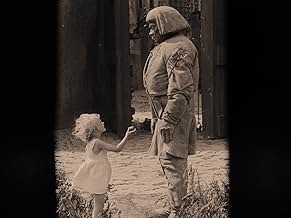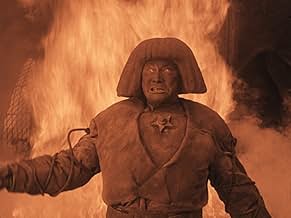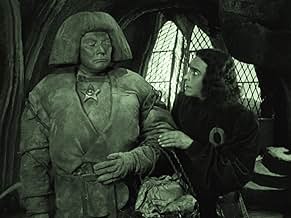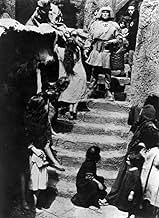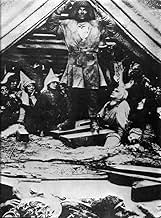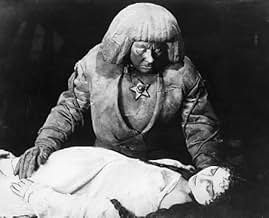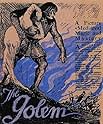VALUTAZIONE IMDb
7,2/10
9154
LA TUA VALUTAZIONE
Nella Praga del XVI secolo, un rabbino crea il Golem, una gigantesca creatura fatta di argilla. Usando la stregoneria, il rabbino dà vita alla creatura per proteggere dalle persecuzioni gli ... Leggi tuttoNella Praga del XVI secolo, un rabbino crea il Golem, una gigantesca creatura fatta di argilla. Usando la stregoneria, il rabbino dà vita alla creatura per proteggere dalle persecuzioni gli ebrei di Praga.Nella Praga del XVI secolo, un rabbino crea il Golem, una gigantesca creatura fatta di argilla. Usando la stregoneria, il rabbino dà vita alla creatura per proteggere dalle persecuzioni gli ebrei di Praga.
- Regia
- Sceneggiatura
- Star
- Premi
- 1 vittoria e 1 candidatura in totale
Hans Stürm
- Der Rabbi Jehuda, der Älteste der Gemeinde
- (as Hans Sturm)
Carl Ebert
- Temple Servant
- (non citato nei titoli originali)
Fritz Feld
- Jester
- (non citato nei titoli originali)
Loni Nest
- Ein kleines Mädchen
- (non citato nei titoli originali)
- …
Ursula Nest
- Little Girl
- (non citato nei titoli originali)
Dore Paetzold
- Des Kaisers Kebse
- (non citato nei titoli originali)
- …
Märte Rassow
- Kind
- (non citato nei titoli originali)
Recensioni in evidenza
This landmark film is one of the earliest surviving expressionist works, and it's art direction and photography-- while not as stunning as a film like Caligari-- is still extremely interesting with its misshapen sets and its use of light and shadow, and light within shadow. Unlike Caligari, the themes of this film were resonant long after its release, and perhaps still are today.
The Golem is a tolerance film that studies in depth the relationship between Jews and Christians in Prague. To his credit, Wegener refuses to impose stereotypes on either party, instead concentrating on individual characters and using mass characterizations only to highlight the themes of the film.
Unlike stereotypical Jews, rich guys with big noses who rub pennies together, the Jews of Prague are decidedly poor. It is interesting to note that the Jews are all dressed in black and with very few exceptions appear to be bent with age, a tribute to an aging and dying religion. However, they are also portrayed to be earnest and hard-working, with strong communal instincts. The Christians, by contrast, appear bright, shiny, and new. They are dressed in light colors and are young and wealthy, and outwardly appear to be God's new chosen. However, they are also portrayed as foolish bohemians who do not take God seriously. In the end, Christian innocents (and blonde-blue Aryan, coincidentally)are able to stop the Golem's rampage, but only because he allows it. The final shot shows the Star of David lying in the dust as the Jews come to carry their fallen champion back into the ghetto, closing the great door behind them and leaving you with a feeling that they are gone forever. However, it should be noted that the Golem is not only a champion to the Jews, but a symbol of revival.
Another interesting comparison in this film is that between the Golem and Jesus. Like man, the Golem is made of sand and clay, then given life by a supernatural force. They are both immaculate conceptions, with the Golem being motherless while Jesus is born to a virgin mother. Jesus in his time was a champion of the Jews, as is the Golem, and each of them rebelled against the wickedness of the authorities that governed them.
This open-ended presentation of the struggle of Christianity vs. Judaism is what makes this film truly great. I suspect that this relevant elevation above the ordinary is the reason for its survival, even though it is the third film of this series. The fact that Wegener was able to make a film that is so ambiguous is a credit to him considering the circumstances surrounding German film-making at the time.
Rabbi Loew is portrayed as a wise and heroic leader of the Jewish community, which lives in a winding ghetto. He creates the Golem for a noble cause-- to protect his people against eviction by the Christians--and in this cause succeeds after the Christian court is saved by the Golem from divine repudiation after laughing at Loew's presentation of the Old Testament. The creation scene is particularly interesting, not only in its visuals, but for the fact that in this scene Rabbi Loew wears white (for purity), yet performs a ceremony that is holy in nature yet seems like witchcraft. The Golem turns on him when he seeks to continue using the Golem's services for selfish purposes after the Golem has accomplished his mission.
Miriam and Loew's servant are portrayed quite differently. Miriam is a dark seductress who is unwittingly the cause of the Golem's destructive rampage. She is only saved from the hands of the Golem by another act of divine intervention, when the communal prayer of the Jews in the streets of the ghetto results in her release. She usually dresses in dark colors. However, there is also a scene before her affair with Florian in which she wears white (purity of a different kind). Also notice how Florian carelessly twirls a flower when he delivers the edict to Rabbi Loew. This is a brief, but effective, example of his character and foreshadows things to come. Loew's servant is the only other young Jewish character in the film besides a few Jewish children in the street, and it is his revival of the Golem during his jealous rage against Florian that sets the Golem on his destructive path. Like Loew, he is unable to remove the Star of David from the Golem's chest once he begins to use the Golem for selfish gain. In the end, he shares a poignant moment with Miriam where they seek forgiveness and confidence about their actions.
The depth and attention to detail that Wegener shows as a director (and writer) in this film helps to place it among the great films in the brief history of cinema. It's message is particularly haunting considering the events of the next 25 years after its release.
The Golem is a tolerance film that studies in depth the relationship between Jews and Christians in Prague. To his credit, Wegener refuses to impose stereotypes on either party, instead concentrating on individual characters and using mass characterizations only to highlight the themes of the film.
Unlike stereotypical Jews, rich guys with big noses who rub pennies together, the Jews of Prague are decidedly poor. It is interesting to note that the Jews are all dressed in black and with very few exceptions appear to be bent with age, a tribute to an aging and dying religion. However, they are also portrayed to be earnest and hard-working, with strong communal instincts. The Christians, by contrast, appear bright, shiny, and new. They are dressed in light colors and are young and wealthy, and outwardly appear to be God's new chosen. However, they are also portrayed as foolish bohemians who do not take God seriously. In the end, Christian innocents (and blonde-blue Aryan, coincidentally)are able to stop the Golem's rampage, but only because he allows it. The final shot shows the Star of David lying in the dust as the Jews come to carry their fallen champion back into the ghetto, closing the great door behind them and leaving you with a feeling that they are gone forever. However, it should be noted that the Golem is not only a champion to the Jews, but a symbol of revival.
Another interesting comparison in this film is that between the Golem and Jesus. Like man, the Golem is made of sand and clay, then given life by a supernatural force. They are both immaculate conceptions, with the Golem being motherless while Jesus is born to a virgin mother. Jesus in his time was a champion of the Jews, as is the Golem, and each of them rebelled against the wickedness of the authorities that governed them.
This open-ended presentation of the struggle of Christianity vs. Judaism is what makes this film truly great. I suspect that this relevant elevation above the ordinary is the reason for its survival, even though it is the third film of this series. The fact that Wegener was able to make a film that is so ambiguous is a credit to him considering the circumstances surrounding German film-making at the time.
Rabbi Loew is portrayed as a wise and heroic leader of the Jewish community, which lives in a winding ghetto. He creates the Golem for a noble cause-- to protect his people against eviction by the Christians--and in this cause succeeds after the Christian court is saved by the Golem from divine repudiation after laughing at Loew's presentation of the Old Testament. The creation scene is particularly interesting, not only in its visuals, but for the fact that in this scene Rabbi Loew wears white (for purity), yet performs a ceremony that is holy in nature yet seems like witchcraft. The Golem turns on him when he seeks to continue using the Golem's services for selfish purposes after the Golem has accomplished his mission.
Miriam and Loew's servant are portrayed quite differently. Miriam is a dark seductress who is unwittingly the cause of the Golem's destructive rampage. She is only saved from the hands of the Golem by another act of divine intervention, when the communal prayer of the Jews in the streets of the ghetto results in her release. She usually dresses in dark colors. However, there is also a scene before her affair with Florian in which she wears white (purity of a different kind). Also notice how Florian carelessly twirls a flower when he delivers the edict to Rabbi Loew. This is a brief, but effective, example of his character and foreshadows things to come. Loew's servant is the only other young Jewish character in the film besides a few Jewish children in the street, and it is his revival of the Golem during his jealous rage against Florian that sets the Golem on his destructive path. Like Loew, he is unable to remove the Star of David from the Golem's chest once he begins to use the Golem for selfish gain. In the end, he shares a poignant moment with Miriam where they seek forgiveness and confidence about their actions.
The depth and attention to detail that Wegener shows as a director (and writer) in this film helps to place it among the great films in the brief history of cinema. It's message is particularly haunting considering the events of the next 25 years after its release.
When I see these old attempts at what amounted to a horror film back then, before my time and I'm an old duffer, I'm always struck at the marvelous Gothic quality wrought by the twisted buildings, the gnarled stairways, the open balconies and the weird angles of things such as doorways, arches, street, bridges and the like. The monstrosities are stark, hardly terrifying by today's CGIs and often terrifying their victims in an almost comical, stylized way. This marvelous film together with Nosferatu and The Cabinet of Dr. Caligari are marvelous pieces of art. There is an ageless quality to them that transcends the hoary and often corny plots and acting. Each must be taken as a whole because that product is always greater than the sum of their parts. Compare the magical Indian Love Call of Nelson Eddy and Jeanette MacDonald, two rather mainstream singers whose voices blend into something greater than either of their individual talents. So too it is, I contend, with these old Gothic classics. Horror? Hardly. But, their starkness and darkness with its twisted surroundings are still eerie and provoking.
In 16th-century Prague, a Jewish rabbi (Albert Steinrück) creates a giant creature from clay, called the Golem, and using sorcery, brings the creature to life in order to protect the Jews of Prague from persecution.
Called "one of the most ambitious productions of the silent era" by Mike Mayo, the film is a blend of religion, astrology and black magic -- mixing Judaism with a conjuring of the demon Astaroth.
The film also has an interesting presentation of anti-Semitism, where the emperor accuses the Jews of killing Christ, among other things, and orders them to evacuate the ghetto. How did Germany in 1920 feel about the Jews? We now know how they felt a decade later, but was this hatred always there or invented by Hitler? If it existed, how did it translate to this film's reception by the German people?
Paul Wegener's face is a wealth of visions -- he manages to use his eyes in such a way that present the golem as simultaneously stoic and intensely emotional.
Others have pointed out that Karl Freund's camera is remarkably still for a man who would go on to be known for the most innovative camera techniques in film history (I dare say he is the greatest cinematographer who ever lived). Mayo says there is an "inventive use of extreme camera angles", but I did not notice. The lack of movement does not hinder the film, however.
Lee Price praises the film, saying the only fault of the film is "the inconsistency of the acting", though I did not find it distracting at all (even if the frightened faces of the extras are a bit extreme). Price calls the architecture of the film as influential (or more so) than the German Expressionism of "Caligari". He is not alone in this view: Ivan Butler makes a point to mention the "strange twisted buildings and crooked streets filled with steeple-hatted inhabitants", and Siegfried Kracauer singles out the "maze of crooked streets and stooped houses" devised by Professor Hans Poelzig.
If you are to see or own this film, I recommend the Kino DVD. Not only is the film cleaned up nicely, with a wonderful score and English title cards, but the supplements are beyond what one would expect from such an old film -- featurettes comparing this movie to "Faust" and the later "Le Golem". I enjoyed them.
Called "one of the most ambitious productions of the silent era" by Mike Mayo, the film is a blend of religion, astrology and black magic -- mixing Judaism with a conjuring of the demon Astaroth.
The film also has an interesting presentation of anti-Semitism, where the emperor accuses the Jews of killing Christ, among other things, and orders them to evacuate the ghetto. How did Germany in 1920 feel about the Jews? We now know how they felt a decade later, but was this hatred always there or invented by Hitler? If it existed, how did it translate to this film's reception by the German people?
Paul Wegener's face is a wealth of visions -- he manages to use his eyes in such a way that present the golem as simultaneously stoic and intensely emotional.
Others have pointed out that Karl Freund's camera is remarkably still for a man who would go on to be known for the most innovative camera techniques in film history (I dare say he is the greatest cinematographer who ever lived). Mayo says there is an "inventive use of extreme camera angles", but I did not notice. The lack of movement does not hinder the film, however.
Lee Price praises the film, saying the only fault of the film is "the inconsistency of the acting", though I did not find it distracting at all (even if the frightened faces of the extras are a bit extreme). Price calls the architecture of the film as influential (or more so) than the German Expressionism of "Caligari". He is not alone in this view: Ivan Butler makes a point to mention the "strange twisted buildings and crooked streets filled with steeple-hatted inhabitants", and Siegfried Kracauer singles out the "maze of crooked streets and stooped houses" devised by Professor Hans Poelzig.
If you are to see or own this film, I recommend the Kino DVD. Not only is the film cleaned up nicely, with a wonderful score and English title cards, but the supplements are beyond what one would expect from such an old film -- featurettes comparing this movie to "Faust" and the later "Le Golem". I enjoyed them.
Imagine shooting a feature-length horror movie with the camera built into your mobile phone. Now imagine disabling sound and colour on your phonecam, only being able to shoot a few seconds at a time, each minute costing a small fortune in recording material, imagine that phonecam being large and unwieldy and kind of knackered so that the already low-resolution image is flickery and erratically exposed, and it plays back too fast so that people look like wound-up dolls. It also exposes blueish light more than reddish light, so each shoot is unpredictable, but of course you'll only know that the next day when the film has been processed.
Welcome to movie-making in the year 1920 AD.
Now go shoot a masterpiece that will still be watched, talked about and revered in a hundred years.
I watched this out of historic interest and expected to be colossally bored. But far from it, this is actually a gripping horror flick, and one with a deep side to it to boot. The Golem himself is an immensely scary horror figure en par with Freddy Kruger or the Alien, kind of a proto-Frankenstein's monster -- and he's actually played by director Paul Wegener himself!. I'd like to know how they made his eyes so scary.
Anyway, what can I say, a stupendous film. Watch it from the edge of your seat.
Welcome to movie-making in the year 1920 AD.
Now go shoot a masterpiece that will still be watched, talked about and revered in a hundred years.
I watched this out of historic interest and expected to be colossally bored. But far from it, this is actually a gripping horror flick, and one with a deep side to it to boot. The Golem himself is an immensely scary horror figure en par with Freddy Kruger or the Alien, kind of a proto-Frankenstein's monster -- and he's actually played by director Paul Wegener himself!. I'd like to know how they made his eyes so scary.
Anyway, what can I say, a stupendous film. Watch it from the edge of your seat.
This is, currently, the only silent movie I have ever seen, and I was unsure how I'd take it. I had heard a lot about this movie and was expecting big things, and I must say I was impressed.
The only major complain I have is that, as with many older classics, I read a review of it prior to buying in which the reviewer gave WAY too much away (the ending sequence, namely).. this has happened to me far too many times. I really wish reviewers wouldn't assume that everyone has already seen the movies they are reviewing, just because they are 'classics'. It really dampened my experience with the ending of both this movie, and The Man with X-Ray Eyes, just to name a few.
Anywho, the version I saw (the Kino remaster) was great. The picture quality was about as good as you could expect from a film more than 80 years old. The score was very good, maybe a tad repetitive, but it suit the film. The acting is quite good, very reminiscant of the acting style from the mid-to-early 20th century.
The scare factor? Well, probably not much these days. The Jewish ghetto is very well constructed, and really suits the setting. The golem himself is not so scary, more goofy to me, but to people in 1920, I can imagine he could have been quite scary. This is more of an 'interest' movie, than an all-out scare fest. You can really see where so many of the great horror/scare films over the years got their ideas from after seeing early films such as this.
I would definately recommend everyone who is interested in horror to track it down. Don't be put off by the fact that it's a silent film, it took all of 20 seconds for me to forget that completely, and to just enjoy the film.
The only major complain I have is that, as with many older classics, I read a review of it prior to buying in which the reviewer gave WAY too much away (the ending sequence, namely).. this has happened to me far too many times. I really wish reviewers wouldn't assume that everyone has already seen the movies they are reviewing, just because they are 'classics'. It really dampened my experience with the ending of both this movie, and The Man with X-Ray Eyes, just to name a few.
Anywho, the version I saw (the Kino remaster) was great. The picture quality was about as good as you could expect from a film more than 80 years old. The score was very good, maybe a tad repetitive, but it suit the film. The acting is quite good, very reminiscant of the acting style from the mid-to-early 20th century.
The scare factor? Well, probably not much these days. The Jewish ghetto is very well constructed, and really suits the setting. The golem himself is not so scary, more goofy to me, but to people in 1920, I can imagine he could have been quite scary. This is more of an 'interest' movie, than an all-out scare fest. You can really see where so many of the great horror/scare films over the years got their ideas from after seeing early films such as this.
I would definately recommend everyone who is interested in horror to track it down. Don't be put off by the fact that it's a silent film, it took all of 20 seconds for me to forget that completely, and to just enjoy the film.
Lo sapevi?
- Quiz"Aemaet", the life-giving word which Rabbi Lowe compels from the spirit Astaroth is also reflected in the bolts of lightning at the end of the creation scene.
- BlooperThe story is set in the 16th Century. A prediction of doom is made based on the movements of Uranus, which was not discovered until 1781.
- Versioni alternativeThe 2002 Alpha Video DVD version runs for 101 minutes. This is not evident from the back of the Alpha Video DVD case, which wrongly lists the running time as only 85 minutes. It looks as if Alpha Video somehow got hold of the fullest version currently known - maybe even a complete version of the film, since there are no obvious gaps in the story.
- ConnessioniEdited into People Who Die Mysteriously in Their Sleep (2004)
I più visti
Accedi per valutare e creare un elenco di titoli salvati per ottenere consigli personalizzati
- How long is The Golem?Powered by Alexa
Dettagli
- Tempo di esecuzione
- 1h 16min(76 min)
- Colore
- Mix di suoni
- Proporzioni
- 1.33 : 1
Contribuisci a questa pagina
Suggerisci una modifica o aggiungi i contenuti mancanti


